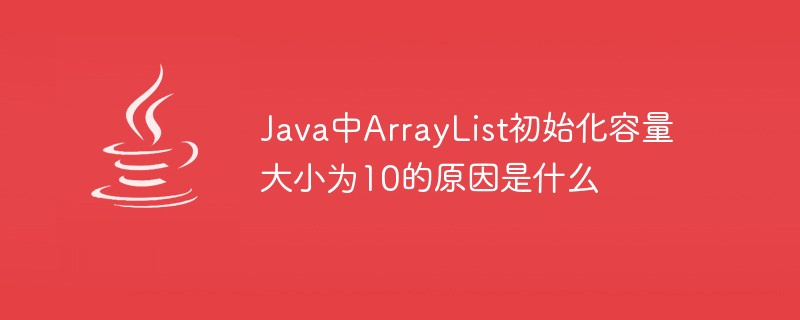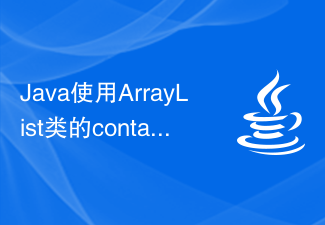The following editor will bring you an article on how to implement Java collection classes ArrayList and LinkedList. The editor thinks it is quite good, so I will share it with you now and give it as a reference for everyone. Let’s follow the editor and take a look.
List’s method list
| Method name | Function description | |
|---|---|---|
| ArrayList() | Construction method, used to create an empty Array list | |
| add(E e) | Adds the specified element to the end of this list | |
| get(int index) | Returns the element at the specified position in this list | |
| size() | Returns the number of elements in this list | |
| clear() | Remove all elements in this list | |
| Returns true if there are no elements in this list | ||
| Remove the element at the specified position in this list | ||
| Returns the index of the first occurrence of the specified element in this list, or -1 if this list does not contain the element | ||
| Returns an array containing all the elements in this list in appropriate order (from first to last element) |
Implementation class ArrayList
package yjlblog;
import java.util.ArrayList;
import java.util.Iterator;
import java.util.List;
public class Test {
public static void main(String[] args) {
List list = new ArrayList();//List 是接口,用多态需要指向它的实现类
list.add("double kill");
list.add("three kill");
list.add("four kill");
list.add("pentakill");
System.out.println(list); //[double kill, three kill, four kill, pentakill]
//默认调用的是tostring 方法,但是这个头string方法不是object里面的,可以查帮助文档可知,是继承的collection的一个方法
System.out.println(list.get(2)); //four kill
String s = (String)list.get(2);//如果用定义变量的形式来表示的话,需要用到强制类型的转换,因为list。get()方法是object的类里的
System.out.println(list.isEmpty());
//false
//list.clear();
//System.out.println(list.isEmpty());
//true
//System.out.println(list.remove(2));//输出制定索引的 被“删除的元素”
list.remove(1);//删除索引为“1” 的元素
System.out.println(list);//[double kill, four kill, pentakill],删除了索引为“1”的元素
System.out.println(list.indexOf("double kill"));//0 输出所指明字符串的 “索引值”
System.out.println(list.size());// 3 ,返回数组的长度
Object[] obj = list.toArray();
System.out.println(obj.length);
//数组的遍历 for 循环
for (int i = 0;i < list.size();i++)
{
System.out.print(list.get(i)+" ");
}
System.out.println();
//使用for each 语句
for (Object x:list)
{
System.out.print(x+" ");
}
System.out.println();
//使用迭代器
//1.先获得list集合的迭代器
Iterator iterator = list.iterator();
//2.通过它的hasNest方法,判断是否遍历完成,用循环实现
while (iterator.hasNext() == true)
{
//3.使用next方法,去除它的下一个元素
System.out.print(iterator.next()+" ");
}
System.out.println();
}
}
//再写上迭代器的说明
//加上arraylist 和 linbkedlist的区别 和代码
//加上后面的几个方法
implements the linked list implementation of the class LinkedList
#List interface, which implements all available Selected list operation and allows all elements (including null). In addition to implementing the List interface, the LinkedList class also provides a unified naming method for get, remove, and insert elements at the beginning and end of the list. These operations allow linked list tables to be used as stacks, queues, or deques.| Function description |
|
|
|---|---|---|
| Inserts the specified element at the beginning of this list | ||
| Adds the specified element to the end of this list | ||
| Remove and return the first element of this list | ||
| Remove and return The last element of this list | ||
| Returns the first element of this list | ||
| Returns the last element in this list |
package yjlblog;
import java.util.ArrayList;
import java.util.Iterator;
import java.util.List;
public class Test {
public static void main(String[] args) {
List list = new LinkedList();//List 是接口,用多态需要指向它的实现类
list.add("double kill");
list.add("three kill");
list.add("four kill");
list.add("pentakill");
System.out.println(list); //[double kill, three kill, four kill, pentakill]
//和ArrayList 的其他方法都是一样的,只是加了一些方法
Traversal of collections
is also mentioned in the above example, see below CodeUse for loopUse for -each loopUse Iterator interfaceEach collection class provides the iterator method to Returns an iterator, through which the collection can be traversed or deleted. The steps for using the iterator are as follows: ****1. Obtain the collection through the Iterator method Iterator2. Determine whether there is the next element by calling the hasNext method3. Use the next method to remove its next element
//数组的遍历 for 循环
for (int i = 0;i < list.size();i++)
{
System.out.print(list.get(i)+" ");
}
System.out.println();
//使用for each 语句
for (Object x:list)
{
System.out.print(x+" ");
}
System.out.println();
//使用迭代器
//1.先获得list集合的迭代器
Iterator iterator = list.iterator();
//2.通过它的hasNest方法,判断是否遍历完成,用循环实现
while (iterator.hasNext() == true)
{
//3.使用next方法,去除它的下一个元素
System.out.print(iterator.next()+" ");
}
System.out.println();The above is the detailed content of Java collection methods to implement classes ArrayList and LinkedList. For more information, please follow other related articles on the PHP Chinese website!
 Java ArrayList遍历时使用foreach和iterator删除元素的区别是什么?Apr 27, 2023 pm 03:40 PM
Java ArrayList遍历时使用foreach和iterator删除元素的区别是什么?Apr 27, 2023 pm 03:40 PM一、Iterator和foreach的区别多态差别(foreach底层就是Iterator)Iterator是一个接口类型,他不关心集合或者数组的类型;for和foreach都需要先知道集合的类型,甚至是集合内元素的类型;1.为啥说foreach底层就是Iterator编写的代码:反编译代码:二、foreach与iterator时remove的区别先来看阿里java开发手册但1的时候不会报错,2的时候就会报错(java.util.ConcurrentModificationException)首
 如何在Java中检查ArrayList是否包含某个元素?Sep 03, 2023 pm 04:09 PM
如何在Java中检查ArrayList是否包含某个元素?Sep 03, 2023 pm 04:09 PM您可以利用List接口的contains()方法来检查列表中是否存在对象。contains()方法booleancontains(Objecto)如果此列表包含指定的元素,则返回true。更正式地说,如果且仅当此列表包含至少一个元素e,使得(o==null?e==null:o.equals(e)),则返回true。参数c-要测试其在此列表中是否存在的元素。返回值如果此列表包含指定的元素,则返回true。抛出ClassCastException-如果指定元素的类型与此列表不兼容(可选)。NullP
 使用LinkedList类的removeLast()方法删除链表中的最后一个元素Jul 24, 2023 pm 05:13 PM
使用LinkedList类的removeLast()方法删除链表中的最后一个元素Jul 24, 2023 pm 05:13 PM使用LinkedList类的removeLast()方法删除链表中的最后一个元素LinkedList是Java集合框架中常见的一种数据结构,它以双向链表的形式存储元素。通过LinkedList类提供的方法,我们可以方便地对链表进行操作,例如添加、删除和修改元素。在某些场景下,我们可能需要删除链表中的最后一个元素。LinkedList类提供了removeLas
 使用java的ArrayList.remove()函数移除ArrayList中的元素Jul 24, 2023 pm 01:21 PM
使用java的ArrayList.remove()函数移除ArrayList中的元素Jul 24, 2023 pm 01:21 PM使用java的ArrayList.remove()函数移除ArrayList中的元素在Java中,ArrayList是一种常用的集合类,用于储存和操作一组元素。ArrayList类提供了许多方法来增删改查集合中的元素。其中一个使用频率较高的方法是remove(),它可以移除ArrayList中的元素。ArrayList的remove()方法有两种重载形式,一
 Java中ArrayList初始化容量大小为10的原因是什么May 10, 2023 pm 02:19 PM
Java中ArrayList初始化容量大小为10的原因是什么May 10, 2023 pm 02:19 PM为什么HashMap的初始化容量为16?在聊ArrayList的初始化容量时,要先来回顾一下HashMap的初始化容量。这里以Java8源码为例,HashMap中的相关因素有两个:初始化容量及装载因子:/***Thedefaultinitialcapacity-MUSTbeapoweroftwo.*/staticfinalintDEFAULT_INITIAL_CAPACITY=1>1);if(newCapacity-minCapacity0)newCapacity=hugeCapacity
 使用java的ArrayList.clear()函数清空ArrayList中的元素Jul 24, 2023 pm 02:04 PM
使用java的ArrayList.clear()函数清空ArrayList中的元素Jul 24, 2023 pm 02:04 PM使用Java的ArrayList.clear()函数清空ArrayList中的元素在Java编程中,ArrayList是一种非常常用的数据结构,它可以动态地存储和访问元素。然而,在某些情况下,我们可能需要清空ArrayList中的所有元素,以便重新使用或释放内存。这时,就可以使用ArrayList的clear()函数来实现。ArrayList.clear()
 Java使用ArrayList类的contains()函数判断元素是否存在Jul 24, 2023 pm 07:33 PM
Java使用ArrayList类的contains()函数判断元素是否存在Jul 24, 2023 pm 07:33 PMJava使用ArrayList类的contains()函数判断元素是否存在在Java编程中,ArrayList是一个非常常用的数据结构。它提供了一种灵活的方法来存储和操作一组数据。除了简单的添加、删除和访问元素之外,ArrayList还提供了一些有用的方法,例如contains()函数,用于判断元素是否存在于ArrayList中。contains()函数是A
 Java程序向LinkedList添加元素Aug 26, 2023 pm 10:21 PM
Java程序向LinkedList添加元素Aug 26, 2023 pm 10:21 PMLinkedList是JavaCollectionFramework的通用类,它实现了List、Deque和Queue三个接口。它提供了LinkedList数据结构的功能,LinkedList是一种线性数据结构,其中每个元素相互链接。我们可以对LinkedList执行多种操作,包括添加、删除和遍历元素。要将元素添加到LinkedList集合中,我们可以使用各种内置方法,例如add()、addFirst()和addLast()。我们将探索如何使用这些方法将元素添加到LinkedList。在Java


Hot AI Tools

Undresser.AI Undress
AI-powered app for creating realistic nude photos

AI Clothes Remover
Online AI tool for removing clothes from photos.

Undress AI Tool
Undress images for free

Clothoff.io
AI clothes remover

AI Hentai Generator
Generate AI Hentai for free.

Hot Article

Hot Tools

SublimeText3 English version
Recommended: Win version, supports code prompts!

DVWA
Damn Vulnerable Web App (DVWA) is a PHP/MySQL web application that is very vulnerable. Its main goals are to be an aid for security professionals to test their skills and tools in a legal environment, to help web developers better understand the process of securing web applications, and to help teachers/students teach/learn in a classroom environment Web application security. The goal of DVWA is to practice some of the most common web vulnerabilities through a simple and straightforward interface, with varying degrees of difficulty. Please note that this software

mPDF
mPDF is a PHP library that can generate PDF files from UTF-8 encoded HTML. The original author, Ian Back, wrote mPDF to output PDF files "on the fly" from his website and handle different languages. It is slower than original scripts like HTML2FPDF and produces larger files when using Unicode fonts, but supports CSS styles etc. and has a lot of enhancements. Supports almost all languages, including RTL (Arabic and Hebrew) and CJK (Chinese, Japanese and Korean). Supports nested block-level elements (such as P, DIV),

Notepad++7.3.1
Easy-to-use and free code editor

PhpStorm Mac version
The latest (2018.2.1) professional PHP integrated development tool






